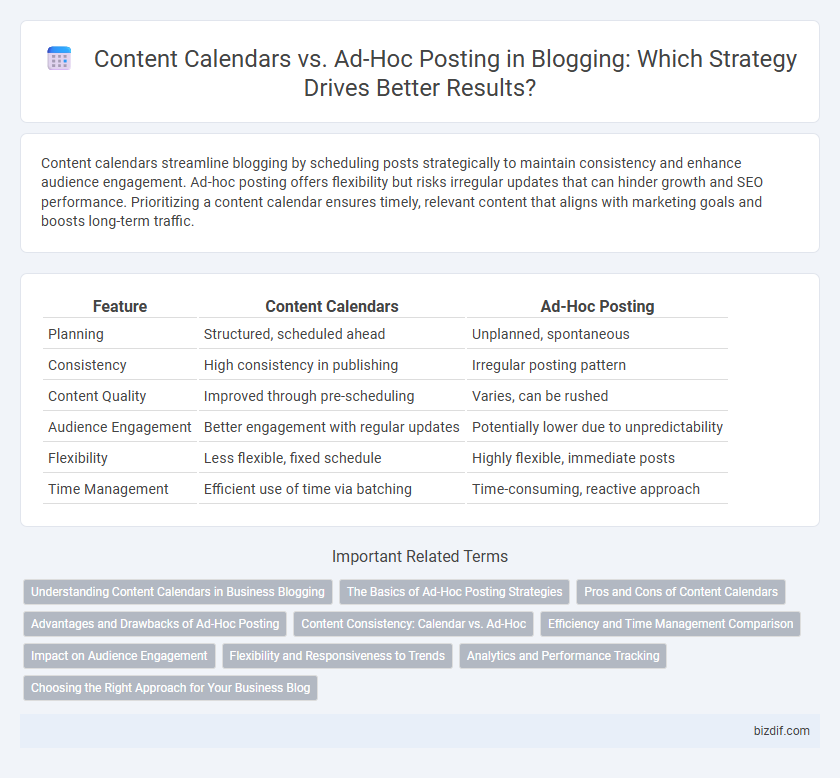Content calendars streamline blogging by scheduling posts strategically to maintain consistency and enhance audience engagement. Ad-hoc posting offers flexibility but risks irregular updates that can hinder growth and SEO performance. Prioritizing a content calendar ensures timely, relevant content that aligns with marketing goals and boosts long-term traffic.
Table of Comparison
| Feature | Content Calendars | Ad-Hoc Posting |
|---|---|---|
| Planning | Structured, scheduled ahead | Unplanned, spontaneous |
| Consistency | High consistency in publishing | Irregular posting pattern |
| Content Quality | Improved through pre-scheduling | Varies, can be rushed |
| Audience Engagement | Better engagement with regular updates | Potentially lower due to unpredictability |
| Flexibility | Less flexible, fixed schedule | Highly flexible, immediate posts |
| Time Management | Efficient use of time via batching | Time-consuming, reactive approach |
Understanding Content Calendars in Business Blogging
Content calendars organize blog posts around strategic themes, deadlines, and audience engagement metrics, ensuring consistent and targeted content delivery. Businesses leveraging content calendars achieve higher SEO rankings by systematically addressing keyword clusters and content gaps. This structured approach contrasts with ad-hoc posting, which often results in irregular publishing and missed opportunities for sustained audience growth.
The Basics of Ad-Hoc Posting Strategies
Ad-hoc posting strategies involve publishing content spontaneously without a fixed schedule, allowing bloggers to respond quickly to trending topics and audience interests. This approach emphasizes flexibility and creativity, often driving higher engagement by addressing real-time events or emerging discussions. However, consistently leveraging ad-hoc posting requires sharp awareness of audience behavior and timely content creation skills to maximize reach and relevance.
Pros and Cons of Content Calendars
Content calendars enable bloggers to plan and organize posts strategically, boosting consistency and audience engagement by ensuring timely, diverse content. They provide clear deadlines and help track performance metrics, reducing last-minute stress and enhancing workflow efficiency. However, rigid adherence to calendars can limit spontaneity and reduce the opportunity to capitalize on trending topics or immediate audience interests.
Advantages and Drawbacks of Ad-Hoc Posting
Ad-hoc posting offers flexibility, allowing bloggers to share spontaneous, timely content that can capture trending topics and engage audiences in real-time. However, this approach risks inconsistency, reducing audience retention and hindering SEO performance due to irregular publishing schedules. Without strategic planning, ad-hoc posting may lead to content gaps and missed opportunities for long-term growth compared to structured content calendars.
Content Consistency: Calendar vs. Ad-Hoc
Content calendars enhance content consistency by enabling strategic planning and regular publishing schedules, which boost audience engagement and SEO performance. In contrast, ad-hoc posting often leads to irregular updates, risking audience retention and reducing search engine visibility. Maintaining a content calendar ensures timely content delivery aligned with marketing goals and seasonal trends, fostering a loyal readership.
Efficiency and Time Management Comparison
Content calendars streamline blogging workflows by providing structured scheduling, which enhances efficiency and ensures consistent posting, minimizing last-minute content creation stress. Ad-hoc posting allows flexibility but often leads to uneven content distribution and increased time spent on planning under pressure. Utilizing content calendars improves time management by allocating dedicated slots for content creation, editing, and promotion, facilitating better resource allocation and audience engagement consistency.
Impact on Audience Engagement
Content calendars enable consistent posting schedules, which boost audience engagement by meeting follower expectations and building trust. In contrast, ad-hoc posting often leads to irregular content delivery, causing decreased audience retention and lower interaction rates. Data shows that brands using content calendars see up to 40% higher engagement compared to those relying on spontaneous posts.
Flexibility and Responsiveness to Trends
Content calendars provide structured timelines to plan consistent blog posts, enhancing organization and long-term strategy. Ad-hoc posting allows greater flexibility and responsiveness, enabling bloggers to capitalize on emerging trends and timely topics quickly. Balancing content calendars with spontaneous posts optimizes audience engagement and relevance in dynamic digital landscapes.
Analytics and Performance Tracking
Content calendars enable consistent scheduling and strategic alignment, which enhances analytics accuracy and performance tracking by providing clear benchmarks and timelines. In contrast, ad-hoc posting leads to irregular patterns, making it difficult to attribute engagement metrics and assess content effectiveness accurately. Leveraging a content calendar improves data-driven decisions by systematically organizing posts and measuring their impact over time.
Choosing the Right Approach for Your Business Blog
Content calendars provide structured planning that enhances consistency, audience engagement, and SEO performance for business blogs. Ad-hoc posting allows flexibility to capitalize on trending topics and real-time events but may lack regularity, impacting growth and search rankings. Evaluating your industry dynamics, audience expectations, and resource availability ensures selecting the most effective content strategy for sustained blog success.
Content calendars vs ad-hoc posting Infographic

 bizdif.com
bizdif.com